Effect of Plant Seed Mixture on Overwintering and Floristic Attractiveness of the Flower Strip in Western Poland
Abstract
1. Introduction
1.1. Environmental Multifunctionality of Flower Strips
1.2. Basics of Flower Strip Establishment
2. Materials and Methods
3. Results
4. Discussion
5. Conclusions
- The selection of the appropriate species composition of mixtures intended for flower strips should take into account not only the preferences of beneficial insects but also environmental conditions, which, to a large extent, determine the success of their cultivation. The possibility of their overwintering is important.
- From the beginning of June to the end of July, the share of flowering plants from the seed bank ranged from 42.59% to 88.19%, while among originally intended plant species, it was only 11.81–57.41%. In May and at the beginning of June, two intended species that were intensively flowering, T. incarnatum with dark-pink inflorescences (in May 70.5%) and P. tanacetifolia with a violet color (at the beginning of June 33.10%), were definitely dominant and are recommended for sowing.
Author Contributions
Funding
Institutional Review Board Statement
Data Availability Statement
Conflicts of Interest
References
- Stoate, C.; Boatman, N.D.; Borralho, R.J.; Carvalho, C.R.; de Snoo, G.R.; Eden, P. Ecological impacts of arable intensification in Europe. J. Environ. Manag. 2001, 63, 337–365. [Google Scholar] [CrossRef] [PubMed]
- Benton, T.G.; Vickery, J.A.; Wilson, J.D. Farmland biodiversity: Is habitat heterogeneity the key? Trends Ecol. Evol. 2003, 18, 182–188. [Google Scholar] [CrossRef]
- Huang, J.; Xu, C.-C.; Ridoutt, B.G.; Wang, X.-C.; Ren, P.-A. Nitrogen and phosphorus losses and eutrophication potential associated with fertilizer application to cropland in China. J. Clean. Product. 2017, 159, 171–179. [Google Scholar] [CrossRef]
- Sánchez-Bayo, F.; Wyckhuys, K.A.G. Worldwide decline of the entomofauna: A review of its drivers. Biol. Conserv. 2019, 232, 8–27. [Google Scholar] [CrossRef]
- Bennekou, S.H. Moving towards a holistic approach for human health risk assessment—Is the current approach fit for purpose? EFSA J. 2019, 17, e170711. [Google Scholar] [CrossRef] [PubMed]
- Kuś, J.; Jończyk, K. Uprawa zbóż w gospodarstwach ekologicznych. Wieś Jutra 2005, 04, 34–36. [Google Scholar]
- Kujawa, K.; Bernacki, Z.; Arczyńska-Chudy, E.; Janku, K.; Karg, J.; Kowalska, J.; Oleszczuk, M.; Sienkiewicz, P.; Sobczyk, D.; Weyssenhoff, D. Kwietne pasy: Rzadko stosowane w Polsce narzędzie wzmacniania integrowanej ochrony roślin uprawnych oraz zwiększania różnorodności biologicznej na terenach rolniczych. Prog. Plant Prot. 2018, 58, 115–128. [Google Scholar]
- Wyss, E.; Pfiffner, L. Biodiversity in Organic Horticulture—An Indicator for Sustainability and a Tool for Pest Management. Acta Hort. 2008, 767, 75–80. [Google Scholar] [CrossRef]
- Fountain, M.T. Impacts of Wildflower Interventions on Beneficial Insects in Fruit Crops: A Review. Insects 2022, 13, 304. [Google Scholar] [CrossRef]
- Buhk, C.; Oppermann, R.; Schanowski, A.; Schanowski, A.; Bleil, R.; Ludemann, J.; Maus, C. Flower strip networks offer promising long term effects on pollinator species richness in intensively cultivated agricultural areas. BMC Ecol. 2018, 18, 55. [Google Scholar] [CrossRef]
- Pfiffner, L.; Wyss, E. Use of sown wildflower strips to enhance natural enemies of agricultural pests. In Ecological Engineering for Pest Management: Advances in Habitat Manipulation for Arthropods; Gurr, G.M., Wratten, S.D., Altieri, M.A., Eds.; CSIRO Publishing: Collingwood, Australia, 2004; pp. 165–186. [Google Scholar]
- Uyttenbroeck, R.; Hatt, S.; Piqueray, J.; Paul, A.; Bodson, B.; Francis, F.; Monty, A. Creating Perennial Flower Strips: Think Functional! Agric. Agric. Sci. Procedia 2015, 6, 95–101. [Google Scholar] [CrossRef]
- Tschumi, M.; Albrecht, M.; Collatz, J.; Dubsky, V.; Entling, M.H.; Najar-Rodriguez, A.J.; Jacot, K. Tailored flower strips promote natural enemy biodiversity and pest control in potato crops. J. Appl. Ecol. 2016, 53, 1169–1176. [Google Scholar] [CrossRef]
- Uyttenbroeck, R.; Hatt, S.; Paul, A.; Boeraeve, B.; Piqueray, J.; Francis, F.; Danthine, S.; Frederich, M.; Dufrêne, M.; Bodson, B.; et al. Pros and cons of flowers strips for farmers. A review. Biotechnol. Agron. Soc. Environ. 2016, 20, 225–235. [Google Scholar] [CrossRef]
- Nicholls, C.I.; Altieri, M.A. Plant biodiversity enhances bees and other insect pollinators in agroecosystems. A review. Agron. Sustain. Dev. 2013, 33, 257–274. [Google Scholar] [CrossRef]
- Amy, C.; Noël, G.; Hatt, S.; Uyttenbroeck, R.; Van de Meutter, F.; Genoud, D.; Francis, F. Flower Strips in Wheat Intercropping System: Effect on Pollinator Abundance and Diversity in Belgium. Insects 2018, 9, 114. [Google Scholar] [CrossRef]
- Rader, R.; Cunningham, S.A.; Howlett, B.G.; Inouye, D.W. Non-Bee Insects as Visitors and Pollinators of Crops: Biology, Ecology, and Management. Annu. Rev. Entomol. 2020, 7, 391–407. [Google Scholar] [CrossRef]
- Schoch, K.; Tschumi, M.; Lutter, S.; Ramseier, H.; Zingg, S. Competition and Facilitation Effects of Semi-Natural Habitats Drive Total Insect and Pollinator Abundance in Flower Strips. Front. Ecol. Evol. 2022, 10, 854058. [Google Scholar] [CrossRef]
- Wix, N.; Reich, M.; Schaarschmidt, F. Butterfly richness and abundance in flower strips and field margins: The role of local habitat quality and landscape context. Heliyon 2019, 5, e01636. [Google Scholar] [CrossRef]
- Tschumi, M.; Albrecht, M.; Entling, M.H.; Jacot, K. High effectiveness of tailored flower strips in reducing pests and crop plant damage. Proc. R. Soc. B 2015, 282, 20151369. [Google Scholar] [CrossRef]
- Jacobsen, S.K.; Sørensen, H.; Sigsgaard, L. Perennial flower strips in apple orchards promote natural enemies in their proximity. Crop Prot. 2022, 156, 105962. [Google Scholar] [CrossRef]
- Herrera, R.A.; Cotes, B.; Agustí, N.; Tasin, M.; Porcel, M. Using flower strips to promote green lacewings to control cabbage insect pests. J. Pest Sci. 2022, 95, 669–683. [Google Scholar] [CrossRef]
- Serée, L.; Chiron, F.; Valantin-Morison, M.; Barbottin, A.; Gardarin, A. Flower strips, crop management and landscape composition effects on two aphid species and their natural enemies in faba bean. Agric. Ecosyst. Environ. 2022, 331, 107902. [Google Scholar] [CrossRef]
- Baggen, L.R.; Gurr, G.M.; Meats, A. Flowers in tri-trophic systems: Mechanisms allowing selective exploitationby insect natural enemies for conservation biological control. Entomol. Exp. Appl. 1999, 91, 155–161. [Google Scholar] [CrossRef]
- Agro Profil. Magazyn Rolniczy. Available online: https://agroprofil.pl/wiadomosci/jakwplywana-uprawe-maja-pasy-kwietnedane-zaskakuja (accessed on 11 May 2022).
- Barbir, J.; Azpiazu, C.; Badenes-Pérez, F.R.; Fernandez-Quintanilla, C.; Dorado, J. Functionality of Selected Aromatic Lamiaceae in Attracting Pollinators in Central Spain. J. Econ. Entomol. 2016, 109, 529–536. [Google Scholar] [CrossRef] [PubMed]
- Holland, J.M.; Bianchi, F.J.; Entling, M.H.; Moonen, A.-C.; Smith, B.M.; Jeanneret, P. Structure, function and management of semi-natural habitats for conservation biological control: A review of European studies. Pest. Manag. Sci. 2016, 72, 1638–1651. [Google Scholar] [CrossRef]
- Nicholson, C.C.; Ricketts, T.H.; Koh, I.; Smith, H.G.; Lonsdorf, E.V.; Olsson, O. Flowering resources distract pollinators from crops: Model predictions from landscape simulations. J. Appl. Ecol. 2019, 56, 618–628. [Google Scholar] [CrossRef]
- Pontin, D.; Wade, M.; Kehrli, P.; Wratten, S. Attractiveness of single and multiple species flower patches to beneficial insects in agroecosystems. Ann. Appl. Biol. 2006, 148, 39–47. [Google Scholar] [CrossRef]
- Jones, J.; Rader, R. Pollinator nutrition and its role in merging the dual objectives of pollinator health and optimal crop production. Phil. Trans. R. Soc. 2022, 377, 20210170. [Google Scholar] [CrossRef]
- Baden-Böhm, F.; Thiele, J.; Dauber, J. Response of honeybee colony size to flower strips in agricultural landscapes depends on areal proportion, spatial distribution and plant composition. Basic Appl. Ecol. 2022, 60, 123–138. [Google Scholar] [CrossRef]
- Ouvrard, P.; Transon, J.; Jacquemart, A.L. Flower-strip agri-environment schemes provide diverse and valuable summer flower resources for pollinating insects. Biodivers. Conserv. 2018, 27, 2193–2216. [Google Scholar] [CrossRef]
- Kujawa, K.; Bernacki, Z.; Kowalska, J.; Kujawa, A.; Oleszczuk, M.; Sienkiewicz, P.; Sobczyk, D. Annual Wildflower Strips as a Tool for Enhancing Functional Biodiversity in Rye Fields in an Organic Cultivation System. Agronomy 2020, 10, 1696. [Google Scholar] [CrossRef]
- Haenke, S.; Scheid, B.; Schaefer, M.; Tscharntke, T. Increasing syrphid fly diversity and density in sown flower strips within simple vs. complex landscapes. J. Appl. Ecol. 2009, 46, 1106–1114. [Google Scholar] [CrossRef]
- Klatt, B.K.; Nilsson, L.; Smith, H.G. Annual flowers strips benefit bumble bee colony growth and reproduction. Biol. Conserv. 2020, 252, 108814. [Google Scholar] [CrossRef]
- Raderschall, C.A.; Lundin, O.; Lindström, S.A.M.; Bommarco, R. Annual flower strips and honeybee hive supplementation differently affect arthropod guilds and ecosystem services in a mass-flowering crop. Agric. Ecosyst. Environ. 2022, 326, 107754. [Google Scholar] [CrossRef]
- Ganser, D.; Knop, E.; Albrecht, M. Sown wildflower strips as overwintering habitat for arthropods: Effective measure or ecological trap? Agric. Ecosyst. Environ. 2019, 275, 123–131. [Google Scholar] [CrossRef]
- Corbet, S.A. Insects, plants and succession: Advantages of long-term set-aside. Agric. Ecosyst. Environ. 1995, 53, 201–217. [Google Scholar] [CrossRef]
- Ullrich, K. The Influence of Wildflower Strips on Plant and Insect (Hetroptera) Diversity in Anarable Landscape. Ph.D. Thesis, Swiss Federal Institute of Technology (ETH), Zürich, Switzerland, 2001. [Google Scholar] [CrossRef]
- Albrecht, M.; Kleijn, D.; Williams, N.M.; Tschumi, M.; Blaauw, B.R.; Bommarco, R.; Campbell, A.J.; Dainese, M.; Drummond, F.A.; Entling, M.H.; et al. The effectiveness of flower strips and hedgerows on pest control, pollination services and crop yield: A quantitative synthesis. Ecol. Lett. 2021, 23, 1488–1498. [Google Scholar] [CrossRef] [PubMed]
- Rollin, O.; Bretagnolle, V.; Decourtye, A.; Aptel, J.; Michel, N.; Vaissiere, B.E.; Mickael, H. Differences of floral resource use between honey bees and wild bees in an intensive farming system. Agric. Ecosyst. Environ. 2013, 179, 78–86. [Google Scholar] [CrossRef]
- Piqueray, J.; Gilliaux, V.; Decruyenaere, V.; Cornelis, J.T.; Uyttenbroeck, R.; Mahy, G. Management of Grassland-like Wildflower Strips Sown on Nutrientrich Arable Soils: The Role of Grass Density and Mowing Regime. Environ. Manag. 2019, 63, 647–657. [Google Scholar] [CrossRef]
- Staab, K.; Yannelli, F.A.A.; Lang, M.; Kollmann, J. Bioengineering effectiveness of seed mixtures for road verges: Functional composition as a predictor of grassland diversity and invasion resistance. Ecol. Eng. 2015, 84, 104–112. [Google Scholar] [CrossRef]
- Beyer, N.; Gabriel, D.; Westphal, C. Contrasting effects of past and present mass-flowering crop cultivation on bee pollinators shaping yield components in oilseed rape. Agric. Ecosyst. Environ. 2021, 319, 107537. [Google Scholar] [CrossRef]
- Ditner, N.; Balmer, O.; Beck, J.; Blick, T.; Nagel, P.; Luka, H. Effects of experimentally planting non-crop flowers into cabbage fields on the abundance and diversity of predators. Biodivers. Conserv. 2013, 22, 1049–1061. [Google Scholar] [CrossRef]
- Hatt, S.; Uyttenbroeck, R.; Lopes, T.; Mouchon, P.; Chen, J.; Piqueray, J.; Monty, A.; Francis, F. Do flower mixtures with high functional diversity enhance aphid predators in wildflower strips? Eur. J. Entomol. 2017, 114, 66–76. [Google Scholar] [CrossRef]
- Schütz, L.; Wenzel, B.; Rottstock, T.; Dachbrodt-Saaydeh, S.; Golla, B.; Kehlenbeck, H. How to promote multifunctionality of vegetated strips in arable farming: A qualitative approach for Germany. Ecosphere 2022, 13, e4229. [Google Scholar] [CrossRef]
- Mei, Z.; de Groot, G.A.; Kleijn, D.; Dimmers, W.; van Gils, S.; Lammertsma, D.; van Kats, R.; Scheper, J. Flower availability drives effects of wildflower strips on ground-dwelling natural enemies and crop yield. Agric. Ecosyst. Environ. 2021, 319, 107570. [Google Scholar] [CrossRef]
- Bilski, Z.; Kajdan-Zysnarska, I. Uprawa roślin bobowatych drobnonasiennych. In Centrum Doradztwa Ekologicznego W Brwinowie; Oddział w Poznaniu: Poznań, Poland, 2019. [Google Scholar]
- Wyłupek, T.; Powroźnik, M.; Widelska, M. Album roślin Miododajnych; Wojewódzki Inspektorat Ochrony Roślin i Nasiennictwa w Lublinie: Lublin, Poland, 2020; pp. 5–53.
- Haaland, C.; Gyllin, M. Butterflies and bumblebees in greenways and sown wildflower strips in southern Sweden. J. Insect Conserv. 2010, 14, 125–132. [Google Scholar] [CrossRef]
- Schmidt, A.; Kirmer, A.; Hellwig, N.; Kiehl, K.; Tischew, S. Evaluating CAP wildflower strips: High-quality seed mixtures significantly improve plant diversity and related pollen and nectar resources. J. Appl. Ecol. 2021, 59, 860–871. [Google Scholar] [CrossRef]
- An Official Website of the Institute of Meteorology and Water Management (IMGW-PIB). Available online: https://www.imgw.pl/wydarzenia/charakterystyka-wybranych-elementow-klimatu-w-polsce-w-sierpniu-2022-roku-podsumowanie (accessed on 29 November 2022).
- Bretagnolle, V.; Gaba, S. Weeds for bees? A review. Agron. Sustain. Dev. 2015, 35, 891–909. [Google Scholar] [CrossRef]
- Rollin, O.; Benelli, G.; Benvenuti, S.; Decourtye, A.; Wratten, S.D.; Canale, A.; Desneux, N. Weed-insect pollinator networks as bio-indicators of ecological sustainability in agriculture. A review. Agron. Sustain. Dev. 2016, 36, 8. [Google Scholar] [CrossRef]
- Brandt, K.; Glemnitz, M.; Schröder, B. The impact of crop parameters and surrounding habitats on different pollinator group abundance on agricultural fields. Agric. Ecosyst. Environ. 2017, 243, 55–66. [Google Scholar] [CrossRef]
- Azpiazu, C.; Medina, P.; Adán, Á.; Sánchez-Ramos, I.; Del Estal, P.; Fereres, A.; Vinuela, E. The Role of Annual Flowering Plant Strips on a Melon Crop in Central Spain. Influence on Pollinators and Crop. Insects 2020, 11, 66. [Google Scholar] [CrossRef] [PubMed]
- Montero-Castaño, A.; Ortiz-Sánchez, F.J.; Vila, M. Mass flowering crops in a patchy agricultural landscape can reduce bee abundance in adjacent shrublands. Agric. Ecosyst. Environ. 2016, 223, 22–30. [Google Scholar] [CrossRef]
- Lindemann-Matthies, P.; Bose, E. Species Richness, Structural Diversity and Species Composition in Meadows Created by Visitors of a Botanical Garden in Switzerland. Landsc. Urban Plan 2007, 79, 281–307. [Google Scholar] [CrossRef]

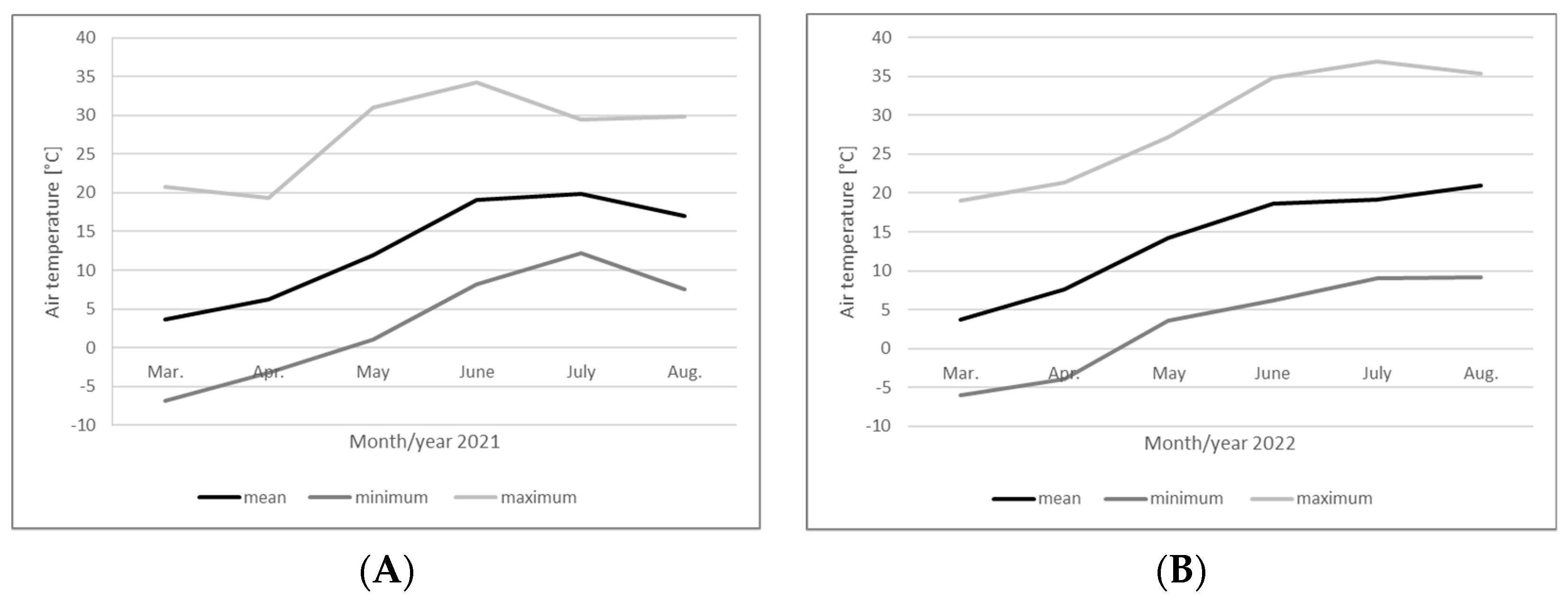

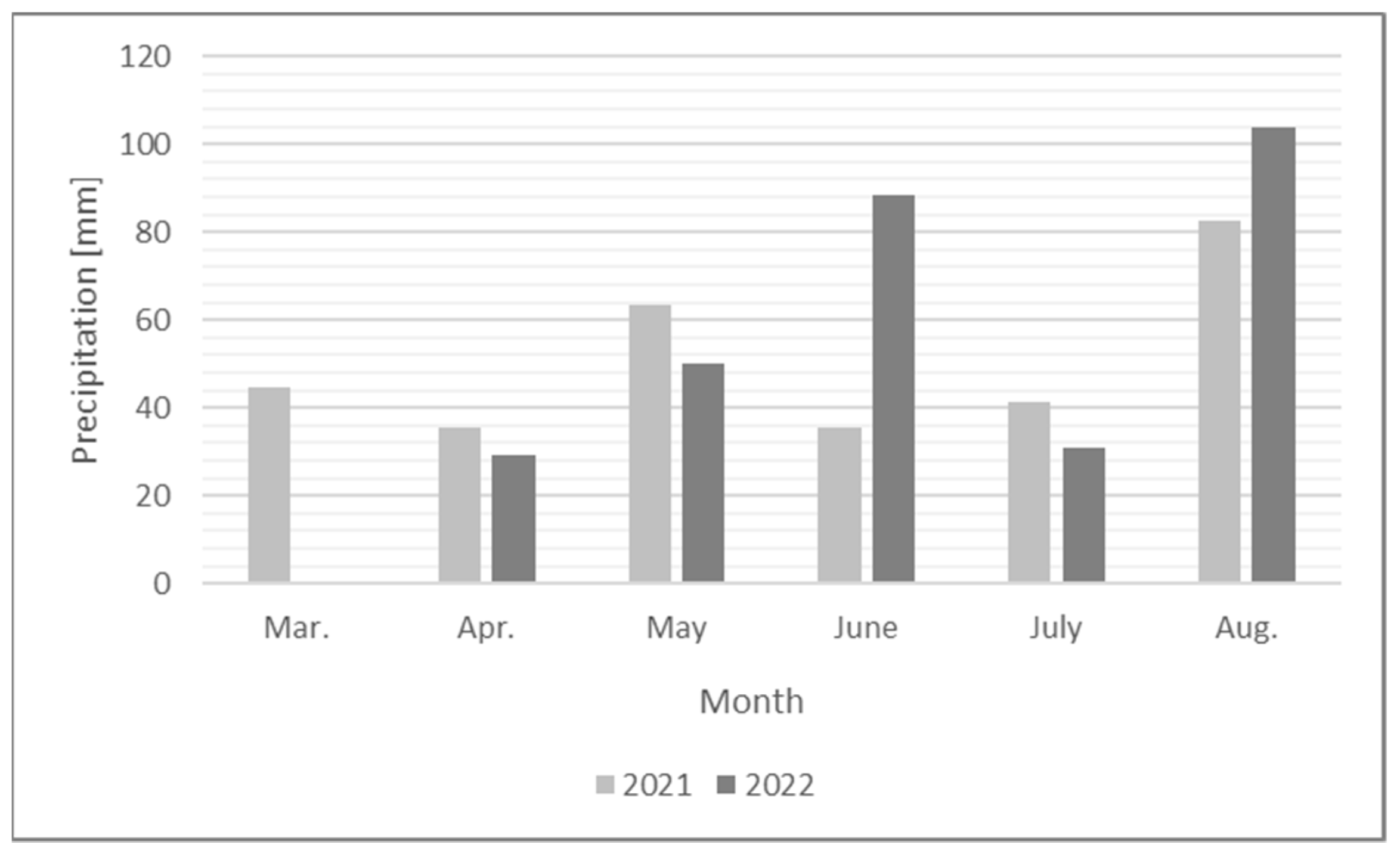
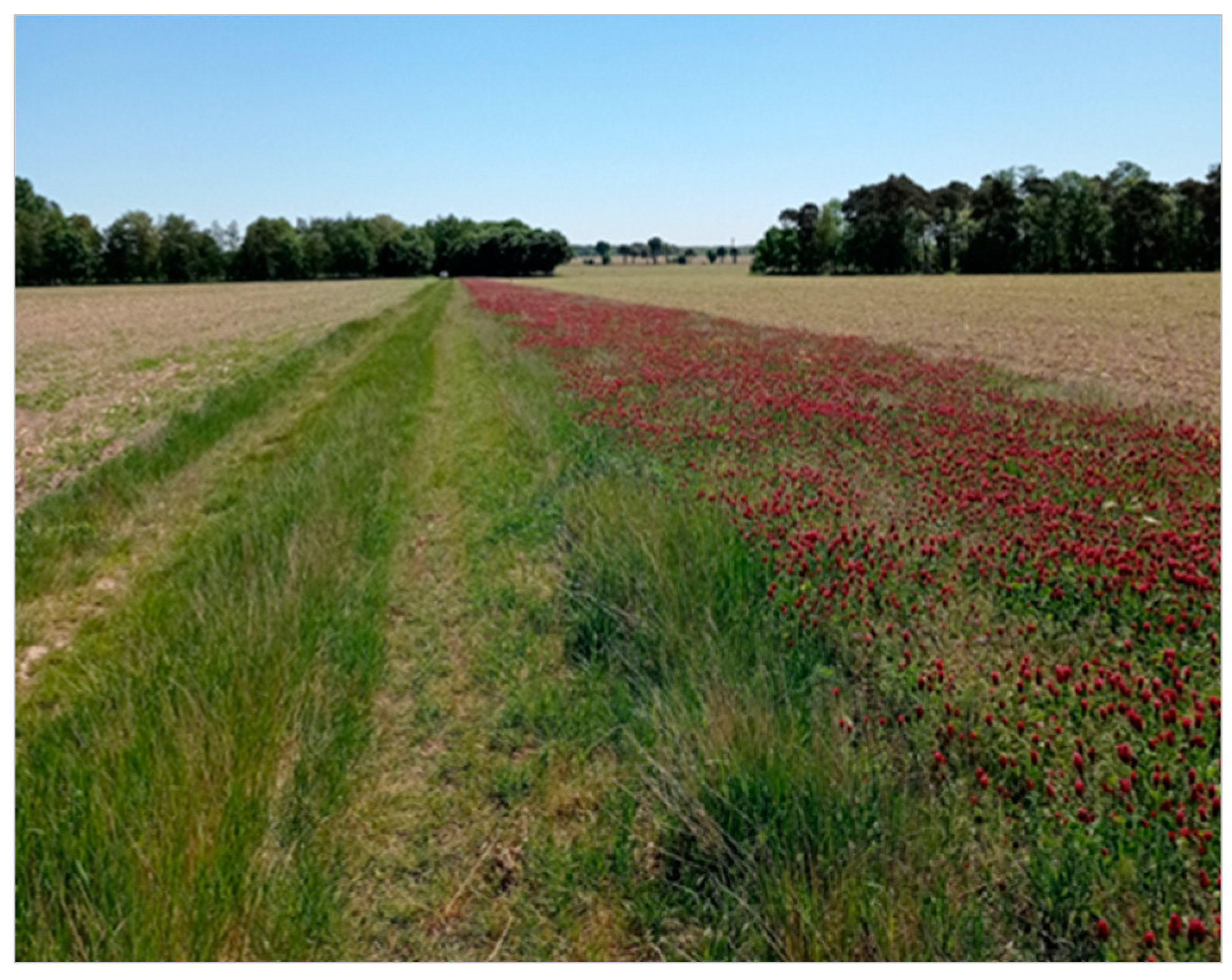
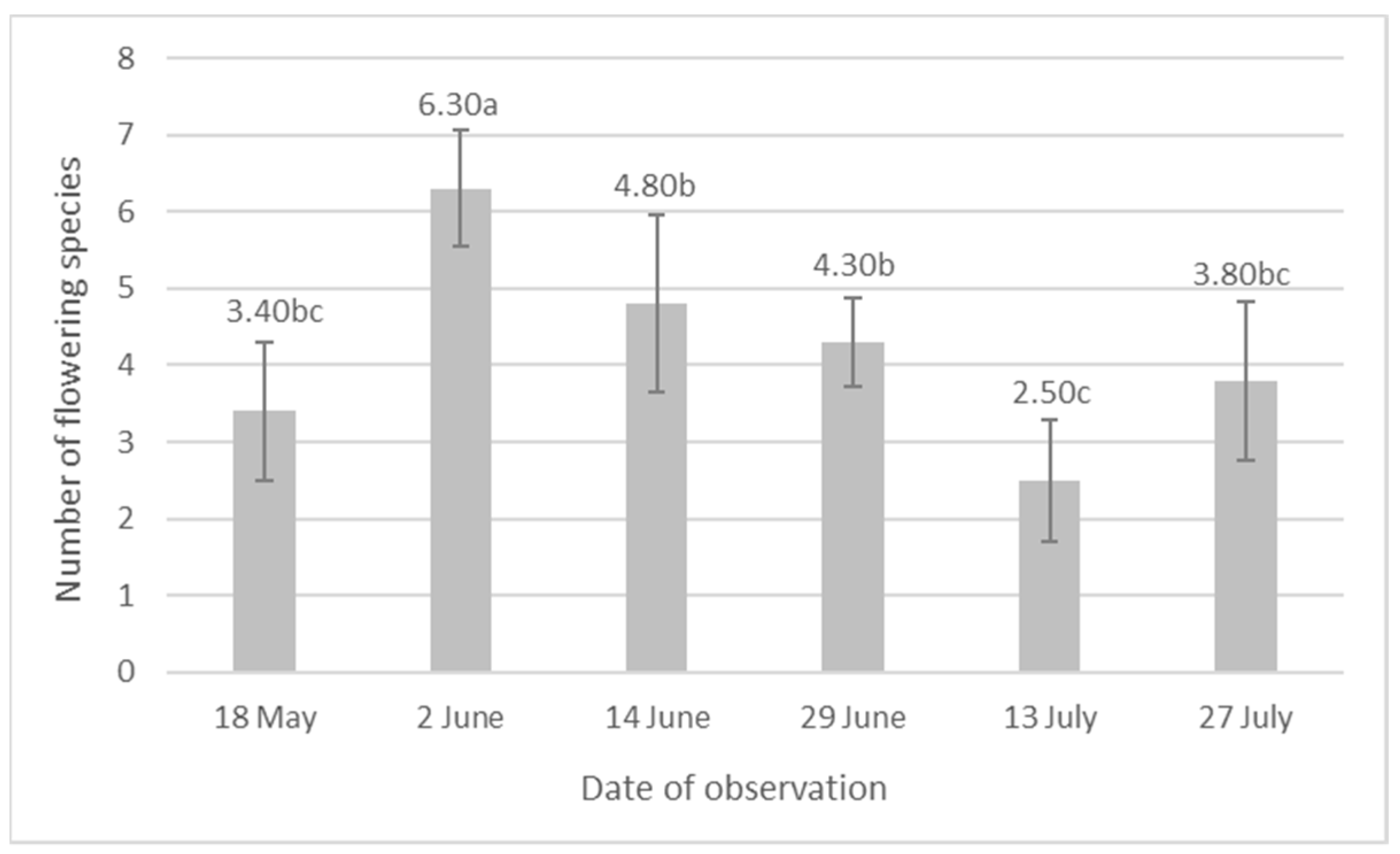
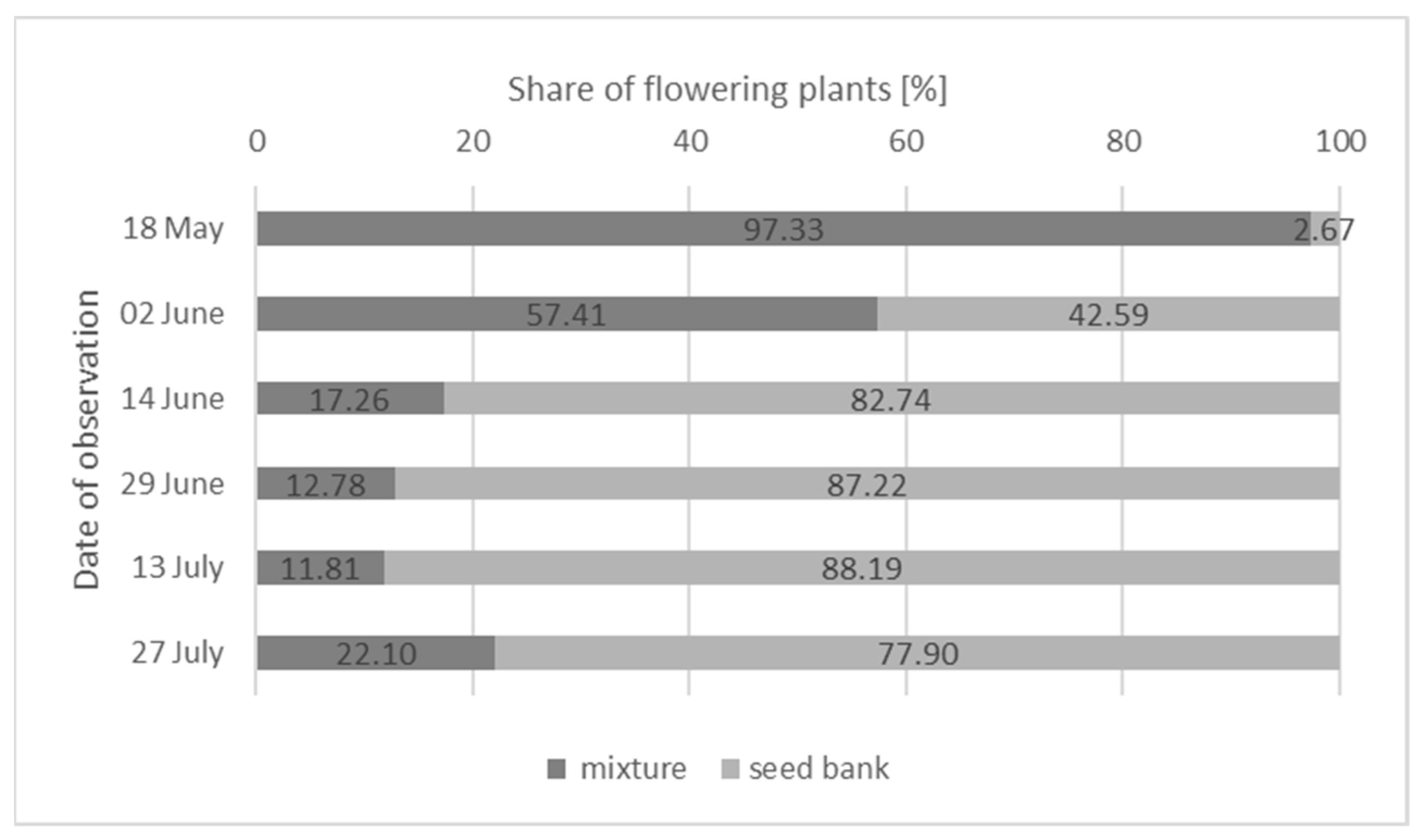
| No. | Species | Family | Life Cycle |
|---|---|---|---|
| 1 | Agrostemma githago L. | Caryophyllaceae | Annual |
| 2 | Borago officinalis L. | Boraginaceae | Annual |
| 3 | Calendula officinalis L. | Asteraceae | Annual |
| 4 | Camelina sativa (L.) Crantz | Brassicaceae | Annual |
| 5 | Carum carvi L. | Apiaceae | Biennial |
| 6 | Centaurea cyanus L. | Asteraceae | Annual |
| 7 | Coriandrum sativum L. | Apiaceae | Annual |
| 8 | Fagopyrum esculentum Moench. | Polygonaceae | Annual |
| 9 | Helianthus annus L. | Asteraceae | Annual |
| 10 | Malva sp. | Malvaceae | Annual |
| 11 | Papaver rhoeas L. | Papaveraceae | Annual |
| 12 | Phacelia tanacetifolia Benth. | Boraginaceae | Annual |
| 13 | Trifolium incarnatum L. | Fabaceae | Annual |
| 14 | Trifolium resupinatum L. | Fabaceae | Annual |
| Plant Origin | Species | Color of Inflorescences | Date of Observations | |||||
|---|---|---|---|---|---|---|---|---|
| 18 May | 2 June | 14 June | 29 June | 13 July | 27 July | |||
| Mixture | Agrostemma githago | Violet | 0.00 | 0.28 | 2.34 | 0.56 | 0.79 | 3.16 |
| Borago officinalis | Blue | 0.00 | 0.00 | 0.00 | 0.00 | 0.00 | 1.05 | |
| Calendula officinalis | Orange | 0.00 | 0.42 | 2.05 | 3.33 | 4.72 | 4.21 | |
| Camelina sativa | Yellow | 0.00 | 0.84 | 0.00 | 0.00 | 0.00 | 0.00 | |
| Carum carvi | White | 0.19 | 0.14 | 0.00 | 0.56 | 0.79 | 1.05 | |
| Centaurea cyanus | Blue | 0.00 | 0.84 | 0.88 | 1.11 | 3.94 | 1.05 | |
| Coriandrum sativum | White | 0.00 | 0.00 | 0.00 | 0.00 | 0.00 | 1.05 | |
| Malva sp. | Violet/pink | 0.00 | 0.14 | 3.22 | 6.11 | 0.00 | 9.48 | |
| Phacelia tanacetifolia | Violet | 26.47 | 33.10 | 6.73 | 1.11 | 1.57 | 1.05 | |
| Trifolium incarnatum | Dark pink | 70.50 | 21.09 | 1.46 | 0.00 | 0.00 | 0.00 | |
| Trifolium resupinatum | Light pink | 0.17 | 0.56 | 0.58 | 0.00 | 0.00 | 0.00 | |
| Seed bank | Anchusa arvensis L. | Blue | 0.18 | 0.00 | 0.00 | 0.00 | 0.00 | 0.00 |
| Arabidopsis thaliana (L.) Heynh. | White, yellow | 0.00 | 0.00 | 0.00 | 0.00 | 0.00 | 42.11 | |
| Capsella bursa-pastoris (L.) Medik. | White | 1.05 | 2.93 | 3.22 | 0.00 | 0.00 | 0.00 | |
| Cirsium arvense (L.) Scop. | Violet | 0.00 | 0.00 | 0.00 | 0.00 | 0.00 | 24.21 | |
| Conyza canadensis L. | White, yellow | 0.00 | 0.00 | 0.00 | 1.11 | 1.57 | 8.42 | |
| Geranium pusillum L. | Light pink | 0.00 | 17.46 | 1.15 | 20.00 | 36.22 | 1.05 | |
| Matricaria chamomilla L. | White, yellow | 0.54 | 18.43 | 59.63 | 6.11 | 0.00 | 0.00 | |
| Tanacetum parthenium (L.) Sch. Bip. | White, yellow | 0.00 | 0.00 | 0.00 | 20.00 | 49.61 | 0.00 | |
| Torilis japonica (Houtt.) D.C. | White | 0.00 | 0.13 | 0.00 | 0.00 | 0.00 | 0.00 | |
| Tripleurospermum maritimum (L.) W. D. J. Koch | White, yellow | 0.00 | 0.00 | 0.00 | 0.00 | 0.00 | 2.11 | |
| Veronica arvensis L. | Blue | 0.00 | 0.99 | 17.84 | 38.89 | 0.00 | 0.00 | |
| Viola tricolor L. | violet, White, yellow | 0.90 | 2.65 | 0.90 | 1.11 | 0.79 | 0.00 | |
| No. | Date of Observations | (SD) | Me (min./max.) | Mean Rank | Kruskal–Wallis Test (5, N = 30) |
|---|---|---|---|---|---|
| 1. | 18 May | 115.60 (±38.29) | 109.50 (58.50/155.50) | 27.2 | H = 23.469 p = 0.0003 |
| 2. | 2 June | 71.60 (±21.04) | 63.00 (53.50/105.00) | 23.0 | |
| 3. | 14 June | 34.20 (±21.25) | 21.50 (18.50/67.00) | 17.6 | |
| 4. | 29 June | 18.00 (±11.44) | 16.00 (6.00/37.00) | 10.9 | |
| 5. | 13 July | 12.70 (±7.96) | 11.00 (2.00/23.50) | 8.8 | |
| 6. | 27 July | 9.50 (±2.98) | 9.00 (5.50/13.50) | 5.5 | |
| Test statistics | ꭓ2 = 18.800 | df = 5 | p = 0.002 | ||
| Significant difference | 1–5 | 1–6 | 2–6 | ||
Disclaimer/Publisher’s Note: The statements, opinions and data contained in all publications are solely those of the individual author(s) and contributor(s) and not of MDPI and/or the editor(s). MDPI and/or the editor(s) disclaim responsibility for any injury to people or property resulting from any ideas, methods, instructions or products referred to in the content. |
© 2023 by the authors. Licensee MDPI, Basel, Switzerland. This article is an open access article distributed under the terms and conditions of the Creative Commons Attribution (CC BY) license (https://creativecommons.org/licenses/by/4.0/).
Share and Cite
Kowalska, J.; Antkowiak, M.; Tymoszuk, A. Effect of Plant Seed Mixture on Overwintering and Floristic Attractiveness of the Flower Strip in Western Poland. Agriculture 2023, 13, 467. https://doi.org/10.3390/agriculture13020467
Kowalska J, Antkowiak M, Tymoszuk A. Effect of Plant Seed Mixture on Overwintering and Floristic Attractiveness of the Flower Strip in Western Poland. Agriculture. 2023; 13(2):467. https://doi.org/10.3390/agriculture13020467
Chicago/Turabian StyleKowalska, Jolanta, Małgorzata Antkowiak, and Alicja Tymoszuk. 2023. "Effect of Plant Seed Mixture on Overwintering and Floristic Attractiveness of the Flower Strip in Western Poland" Agriculture 13, no. 2: 467. https://doi.org/10.3390/agriculture13020467
APA StyleKowalska, J., Antkowiak, M., & Tymoszuk, A. (2023). Effect of Plant Seed Mixture on Overwintering and Floristic Attractiveness of the Flower Strip in Western Poland. Agriculture, 13(2), 467. https://doi.org/10.3390/agriculture13020467








